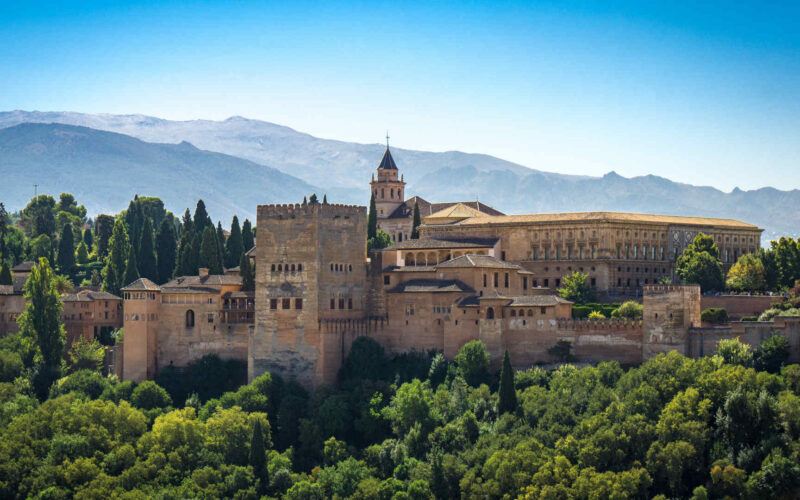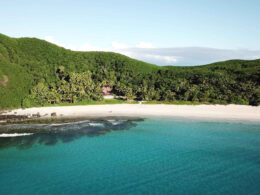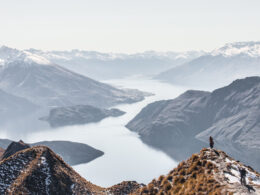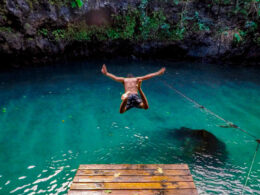Upon landing in Papeete, you immediately notice that French Polynesia doesn’t quite seem real. The kind of unreal where one squints at the hues of blue in the lagoon, wondering if nature accidentally turned up the saturation. It’s the kind of place that, if not careful, can make a hard-working digital nomad forget why they even needed WiFi in the first place.
Now, there’s more to a location than just turquoise waters and overwater bungalows (though they surely don’t hurt). Reliable internet, cozy working spaces, and perhaps a café that wouldn’t mind one occupying a table for hours on end, nursing a single café au lait, are all crucial. And it’s here that French Polynesia, quite surprisingly, has more to offer than one might think.
Tahiti and her sister islands have started winking at the laptop-clad wanderers of the world. In between sips of coconut water, one can find quaint cafés with surprisingly strong WiFi signals, capable of supporting a Zoom call without too much pixelation. And when one’s devices reminds them of the ‘unhealthy screen time’, there’s no better way to take a break than with a lazy paddle among friendly stingrays.
Yet, the true delight of French Polynesia for the digital nomad is the locals. The Polynesians, with their rich history of navigating vast oceans, seem to understand the nomad spirit. They’re welcoming, helpful, and genuinely curious. It’s the sort of place where your Airbnb host might invite you for a homemade Poisson Cru dinner and share tales of ancestors navigating by the stars.
But, a word of caution: While working remotely in French Polynesia, there’s a risk, albeit a pleasant one. You might just decide that your ‘temporary’ paradise workspace deserves a more permanent status. And who could blame you? In the intoxicating embrace of the Polynesian breeze, deadlines seem less pressing, and the siren song of the South Pacific becomes almost impossible to resist.
I. The Basics
Cost of Living
Paradise, as one might expect, comes with its price tag. While the allure of turquoise waters, pristine beaches, and vibrant marine life is undeniable, it’s essential to navigate the financial currents of this tropical haven. The cost of living here, influenced by its remote location and heavy reliance on imports, can swing between the delightfully affordable to the indulgently luxurious. Whether you’re indulging in a meal by the lagoon or hopping between islands, every expense tells a story of an economy built on both tourism and tradition.
- Accommodation:
- Budget Lodging (pensions/guesthouses): $50 – $100 per night.
- Mid-Range Hotels: $150 – $350 per night.
- Luxury Resorts (Overwater bungalows): $400 – $1,200+ per night.
- Food:
- Local eateries (‘Roulottes’ or food trucks): $10 – $20 per meal.
- Mid-Range Restaurants: $30 – $60 per meal.
- High-end Restaurants: $70 – $150+ per meal.
- Transportation:
- Domestic Flights (between islands): $50 – $300 round trip, depending on distance and season.
- Car Rental: $40 – $80 per day.
- Public Transport (Buses): $2 – $4 per ride.
- Leisure Activities:
- Snorkeling and Diving tours: $50 – $150.
- Lagoon Excursions: $70 – $200.
Connectivity and Infrastructure
In the heart of the South Pacific, French Polynesia may surprise you with its connectivity. Most hotels and quaint cafés generously offer WiFi, the speed and reliability can sometimes still be a game of chance. For those who can’t afford to leave their digital commitments to luck, a local SIM card with a hearty data package is a wise investment. It might set you back between $20 and $50, but peace of mind, especially on a deadline, is priceless.
Power-wise, French Polynesia adheres to a standard voltage of 220V and a frequency of 60Hz, and their sockets are designed for French 2-pin plugs. So, if you’re carrying a cache of electronic devices, an adapter is a must-have in your travel kit.
Transport infrastructure, especially in Tahiti, is commendable. Roads are in good condition, and public buses, although not as frequent as in bustling cities, provide a reliable mode of transport. If you’re venturing to the smaller islands, however, be prepared for a simpler infrastructure. Roads may be less developed, and public transport options might be limited.
Lastly, while French Polynesia does have airports sprinkled across its islands, inter-island transport is predominantly facilitated by boats. The ports are well-equipped, and ferry services are quite systematic, making island-hopping both an adventure and a breeze.
Healthcare
Your health in French Polynesia is in good hands. Tahiti proudly hosts the archipelago’s most advanced healthcare facilities. But if you find yourself on one of the smaller, more remote islands and face a serious ailment, be prepared for a possible scenic flight back to Tahiti.
Even paradise has its terms and conditions, and one of those here is ensuring you arrive with comprehensive health insurance. While the healthcare quality would make any European nod with approval, the bills can swiftly dispel any relaxation your beach meditation achieved.
And while you’re updating your travel checklist, throw in routine vaccinations. The islands don’t demand any particular shots, but it’s always better to be safe than sorry.
Safety
The islands of French Polynesia wear their serenity not just in their landscapes but also in their safety records. Petty thefts, mostly targeting the unsuspecting tourist, do occasionally disrupt this paradise, but violent crimes are rare.
Nature however does have its moods. Between November and April, the skies occasionally grumble, and cyclones sweep through. Staying updated with local weather advisories isn’t just a recommendation—it’s a must. And while the inviting blue waters beckon for a swim, approach with a sprinkle of caution. Strong currents can lurk beneath those calm surfaces, and always respect local advice about marine creatures and safe diving spots.
After all, it’s in everyone’s best interest that your most dramatic story from French Polynesia involves an adventurous kayak trip and not an unexpected trip to the hospital.
II. Living in French Polynesia as a Digital Nomad
Climate
French Polynesia, being in the heart of the tropics, generally enjoys a balmy, warm climate. The annual temperature hovers between 24°C (75°F) and 30°C (86°F). However, there are two distinct seasons:
- Wet Season (November to April): This period, often referred to as the summer months, is characterized by higher humidity and temperatures ranging from 26°C (79°F) to 31°C (88°F). Rain showers can be frequent and intense, often accompanied by high humidity. The wet season also coincides with the cyclone season, so while cyclones are rare, they are not unheard of.
- Dry Season (May to October): The winter months, or the tourist high season, are cooler and less humid. During this time, temperatures typically range from 24°C (75°F) to 28°C (82°F). The dry season offers a more comfortable climate for outdoor activities and, for digital nomads, a refreshing ambiance for work.
Nature
When one steps onto any island within this Pacific haven, it’s clear: nature here doesn’t simply exist—it sings, dances, and captivates. Each island is a unique verse in a timeless ballad.
At the heart of many of these islands are the dramatic peaks and valleys, remnants of volcanic fervor from millennia past. They rise majestically, clothed in the deepest greens, as if challenging the skies. Waterfalls cascade from these heights, tracing a shimmering path through dense foliage, serenading the forests with their gentle murmurs.
But while these mountains whisper tales of ancient fire and power, the shores and surrounding waters resonate with a different energy. The lagoons, in hues of blue one could scarcely imagine, act as nature’s canvases. Coral reefs, the underwater metropolises, are abuzz with life. Schools of fish, in colors that could put rainbows to shame, flit between corals. Sharks and rays, the regal denizens of this watery realm, glide gracefully, embodying both beauty and power.
Then there are the atolls, the quieter, flatter siblings of the mountainous islands. Here, tranquility reigns supreme. The stillness is only occasionally interrupted by the rustling of palm leaves or the distant call of a seabird. These sandy outcrops, encircling lagoons, stand as sentinels in the vast ocean, offering respite to both weary travelers and nesting birds.
Lifestyle
In the islands, there’s a rhythm of life so profoundly distinct that it’s almost tangible in the air. It’s a place where the digital urgency of ‘now’ collides with the leisurely pace of ‘island time’. Here, traditions aren’t just tales told but are lived experiences. The concept of ‘Mana’, an ancient spiritual force, is woven deeply into the very fabric of daily life. It’s believed to flow through everything—people, objects, and nature, guiding and influencing life.
As a digital nomad, stepping into this realm requires a subtle recalibration of the internal clock. But once aligned, the reward is a refreshing break from the frenetic pace of digital life. The close-knit communities, with their warmth and inclusive nature, make it easy. They cherish communal values, and it’s not uncommon for neighbors to share meals or for the entire village to come together for festive occasions.
On the culinary front, French Polynesia serves as a delightful playground for the palate. Here, the bounties of the ocean meet the rich harvest of the land. The cuisine is an aromatic blend of traditional Polynesian flavors intensified by French flair. Seafood, naturally, is a star. Whether it’s the tantalizing ‘Poisson Cru’, fresh fish marinated in citrus juices and mixed with creamy coconut milk, or dishes delightfully cooked in ‘ahima’a’, an earth oven – every bite tells a tale. Taro, breadfruit, and sweet potatoes often make their way to the table, offering a hearty complement to the main courses.
But as the sun dips below the horizon, the islands come alive in a different hue. Tahiti and Moorea, the more cosmopolitan siblings, pulsate with energy. Beachfront bars hum with chatter, glasses clink, and the soft strumming of ukuleles fills the air. Traditional dance performances, or ‘Tamure’, with their vibrant costumes and hypnotic beats, often become the highlight of the night. But if you find yourself on one of the quieter islands, fear not. The definition of nightlife shifts from loud music to soft whispers of the ocean, from neon lights to a canopy of stars, and from dancing in clubs to sharing tales with locals over a shared meal. In these moments, you’ll find that the real allure of French Polynesia isn’t just in its scenic beauty, but in the symphony of experiences it offers.
Culture
The culture of French Polynesia is a narrative woven from threads of ancient legends, tribal traditions, and European influences. Every island has its tale, whispered by the winds, echoed in the waves, and celebrated in the dances of its people. The Marae, ancient Polynesian temples made of stone, stand as silent testaments to a time when gods, warriors, and chieftains walked the earth. These sacred grounds, especially the Marae Taputapuātea on Raiatea, beckon visitors to pause and reflect on the rich tapestry of Polynesian mythology.
European explorers, most notably Captain James Cook and the French, further enriched this cultural blend, adding layers of history, religion, and governance. But, the essence of Polynesia was resilient. The Heiva festival, celebrated annually, bursts forth in vibrant displays of traditional dance, song, and sports. It is a jubilant assertion of identity, a homage to ancestors, and a celebration of life.
As for attractions, apart from the natural marvels, one can visit the Robert Wan Pearl Museum in Tahiti to understand the allure of the Tahitian black pearl. The Paul Gauguin Museum, also in Tahiti, offers a glimpse into the life and works of the famous artist who once called these islands home.
Language
Tahitian and French are the primary languages of French Polynesia. While Tahitian is steeped in the nuances of the islands and is the heart of many local songs and stories, French is the administrative and official language. In tourist hubs and business centers, English is relatively well-understood, especially within the hospitality sector.
For digital nomads, this multilingual setting can be both a delight and a challenge. Simple phrases in Tahitian, like “Ia ora na” (hello) or “Māuruuru” (thank you), can go a long way in endearing oneself to locals. Most signs, menus, and official documents will be in French, so a basic understanding can be quite helpful.
III. Cities to Consider in French Polynesia
While French Polynesia is more renowned for its idyllic islands than bustling cities, there are a few hubs that digital nomads might find intriguing, offering a blend of local culture, convenience, and connectivity.
Papeete

As the capital city of French Polynesia, Papeete is the most urbanized area you’ll encounter in the region. It boasts the best infrastructure, with the Faa’a International Airport serving as the primary gateway to the islands. Here, you’ll find a fusion of French and Polynesian cultures – from the lively Papeete Market offering local crafts to elegant boutiques and cafes. For a nomad, Papeete offers the most consistent internet connectivity, along with co-working spaces and modern amenities.
Moorea

A short ferry ride from Tahiti, Moorea offers a more relaxed vibe. It’s a paradise for nature lovers, with stunning lagoons, mountainous landscapes, and lush gardens. While it’s not a city in the conventional sense, its proximity to Papeete means you won’t be sacrificing modern conveniences. Resorts and larger hotels usually offer good internet connectivity, and the island vibe can be incredibly inspiring for creative work.
Bora Bora

Often dubbed the ‘jewel of the South Seas’, Bora Bora is synonymous with luxury. While staying long-term here might be pricier than other areas, the experience is unparalleled. The main village, Vaitape, offers essential services, shops, and a few dining options. If your work requires occasional high-speed internet rather than consistent connectivity, the luxury resorts might be your best bet.
Raiatea

Raiatea holds a special place in Polynesian history and culture, home to the revered Marae Taputapuātea. Uturoa, the main town, has a relaxed atmosphere with a marina, shops, and some cafes. As the administrative center of the Leeward Islands, it has reasonable infrastructure. While not as bustling as Papeete, Raiatea offers a balance of modern amenities in a serene setting.
For digital nomads, choosing a base in French Polynesia depends on their preferences and work requirements. Whether you seek urban comforts, nature-inspired serenity, or a touch of luxury, the islands offer a space for every kind of wanderer.
IV. Off the Beaten Track
While the glittering shores of Bora Bora or the bustling streets of Papeete might draw the lion’s share of visitors, French Polynesia harbors hidden gems, waiting for the intrepid traveler to discover. Venturing off the beaten track in this Pacific paradise reveals islands and atolls where time seems to stand still, where the imprint of modernity is faint, and the embrace of nature is all-encompassing.
Maupiti

Just a short flight from its more famous counterpart, Maupiti is like a serene echo of Bora Bora, without the luxury resorts and throngs of tourists. The island is encircled by a coral atoll and dotted with small ‘motus’ or islets. With only a few guesthouses and no cars, it’s an oasis of tranquility, perfect for digital nomads seeking solitude and inspiration.
Fakarava (Tuamotu Archipelago)

A UNESCO Biosphere Reserve, Fakarava is a diver’s dream. The coral-rich lagoon boasts incredible underwater biodiversity, including schools of sharks and vibrant coral formations. On land, the slow pace of life is dictated by the rhythms of the sea. With only a handful of guesthouses and a sparse population, it’s a haven for those looking to immerse themselves in untouched nature.
Tahuata (Marquesas Islands)

The smallest inhabited island of the Marquesas, Tahuata is known for its intricate bone carvings and tattoos, echoing ancient Polynesian traditions. Its secluded bays, like Hanamoenoa and Hapatoni, are framed by towering cliffs and verdant valleys. With no airport, access is by boat from the nearby island of Hiva Oa, adding to its secluded charm.
Rurutu (Austral Islands)

Rurutu stands out with its unique topography, riddled with limestone caves and cliffs. Between July and October, the waters surrounding Rurutu become a playground for humpback whales, making it a prime spot for whale watching. The island’s culture is deeply rooted in age-old traditions, with festivals and crafts that are distinct from the rest of French Polynesia.
Mangareva (Gambier Islands)

Far to the southeast, Mangareva is the central island of the Gambier archipelago. Known for producing exquisite black pearls, the island is dotted with pearl farms. The remnants of ancient Polynesian civilization, like stone temples and old forts, coexist with Catholic landmarks, reflecting its history as a hub of French missionary activity.
Exploring off the beaten track in French Polynesia offers digital nomads not just the luxury of solitude but also a deeper connection to the land, the sea, and the age-old traditions of its people. It’s in these less-trodden paths that one often finds the true essence of a place.
V. Visas for Digital Nomads in French Polynesia
French Polynesia, an overseas collectivity of France, has its visa regulations influenced by French law. While it remains a paradise for vacationers, digital nomads looking to extend their stay should be aware of the legal pathways available to them.
1. Tourist Visa
Overview: The Tourist Visa allows visitors to stay in French Polynesia for up to 90 days within a 180-day period. This visa is ideal for digital nomads who plan a short stay without engaging in local employment. Citizens from many countries, including the US and EU, can enter visa-free for short stays.
Application Process: To apply for a Tourist Visa, if required, the applicant must submit their application at a French consulate or embassy before traveling. Upon arrival, present the necessary documentation at the immigration counter to receive the visa stamp.
Documentation Required:
- A valid passport with at least six months validity.
- Proof of return or onward travel.
- Evidence of sufficient funds for the duration of the stay.
- Accommodation details.
2. Long-Stay Visa (Visa de long séjour)
Overview: The Long-Stay Visa is for those intending to stay in French Polynesia for more than 90 days. This visa can be used for various purposes, including personal or professional reasons, and may suit digital nomads planning an extended stay.
Application Process: To apply for a Long-Stay Visa, gather all necessary documents and submit the application at a French consulate or embassy. Once approved, register with local authorities in French Polynesia upon arrival.
Documentation Required:
- Valid passport.
- Proof of long-term accommodation.
- Evidence of financial means to support the stay.
- Health insurance valid for the duration of the stay.
- Clean criminal record certificate.
3. Residence Permit (Carte de séjour)
Overview: The Residence Permit is suitable for individuals planning to stay longer than a year. Initially, you enter with a Long-Stay Visa and then apply for a residence permit once in French Polynesia. This is a more permanent solution, suitable for those looking to reside long-term.
Application Process: After arriving in French Polynesia with a Long-Stay Visa, apply for the residence permit at the local immigration office. This involves submitting additional documentation and possibly attending an interview.
Documentation Required:
- Valid passport.
- Proof of sufficient financial resources.
- Evidence of accommodation in French Polynesia.
- Health insurance.
- Clean criminal record certificate.
- Proof of income or business activities if applicable.
For the most current and detailed information, always consult the official Tahiti Tourism website and the French Polynesia Immigration Portal.
VI. Tips for a Smooth Landing
Embarking on a journey to French Polynesia is like stepping into a postcard. Its lush, vibrant isles are captivating, and the thought of settling, even temporarily, in such an idyll is exhilarating. But, like any new place, there are a few practical considerations to understand.
Accommodation
When it comes to finding a place to lay your head, many start their search in the digital realm, perusing platforms such as Airbnb or Booking.com. These sites offer everything from the dreamy overwater bungalows that seem to float on azure waters to quaint local “pensions”, the Polynesian equivalent of a guesthouse. But there’s a world beyond the screen. Local real estate agencies often have treasures not found online, and a chat at a local café might just lead to the best housing deal you’ve ever had. For the digital nomad, proximity to the more bustling islands like Tahiti or Moorea might be key, ensuring that internet connectivity remains strong. Yet, for those yearning for an immersive, somewhat off-grid experience, the smaller islands beckon.
Finances
The archipelago has its fair share of international banks. Yet, the act of opening an account can be a dance in itself, often requiring a string of documents and possibly a local reference. The currency here, the CFP franc, while exotic, is essential, especially when meandering through the more remote pockets of the islands where the digital world, including credit cards, seems eons away. And, while on the topic of earnings and spendings, a rendezvous with a local tax consultant might be a wise move for the earning nomad.
Transport
Travel here is an experience. The vastness of French Polynesia means that the skies are as much a highway as the seas. Air Tahiti dominates the skies, connecting islands that are hours apart, while ferries, especially between closer neighbors like Tahiti and Moorea, offer a more grounded experience. On land, the larger towns bustle with buses, albeit ones that move to the leisurely “Polynesian time”. Rentals, be it cars or scooters, are popular for those seeking adventures on their own terms. And, for the brave-hearted, the smaller islands even offer the charm of hitchhiking.
Customs
But beyond the logistics, there’s the soul of the place, wrapped up in its customs and cultural nuances. A cheerful “Ia ora na” can light up faces, and while French is the lingua franca, many locals in tourist hubs converse easily in English. The islands might seem perpetually dressed for a beach party, but a touch of modesty, especially in local or religious settings, is appreciated. Time, as mentioned, has its own pace here. It’s languid, relaxed, stretching moments into memories. And, should you be fortunate to be invited into a local’s abode, remember, a small token of appreciation is a lovely touch.
VII. Verdict
1. Quality of Life
1. Quality of Life2. Cost of Living
2. Cost of Living3. Connectivity and Infrastructure
3. Connectivity and Infrastructure4. Visas
4. Visas5. Verdict
5. VerdictOne might imagine, especially after a particularly irksome Zoom call, that relocating one’s desk to a place where the WiFi signal competes with the songs of humpback whales, is a splendid idea. Here, the word ‘office’ has the potential to be synonymous with ‘beachfront’. There’s a magic in the thought of typing away, punctuating each sentence with a sip of fresh coconut water, the horizon stretching endlessly with hues of blues and greens one didn’t know existed.
But, as enchanting as the archipelago is, it does occasionally remind one of the delicate balancing act of life, and any seasoned traveler would whisper in your ear “there’s more to it than meets the eye”. The internet, for instance. While Tahiti might boast of a commendable connection, venturing to the smaller islands might mean your video calls are occasionally serenaded by the ‘buffering’ icon. A small price, you might think, until you’re presented with the actual price of living amidst such splendor. Let’s just say, the numbers do remind you, paradise is a premium.
Yet, for every con there’s a compelling pro. Each sporadic internet disconnection is an unplanned invitation to gaze at the vastness of the Pacific. Every penny spent more feels justified with the unparalleled vibrancy and warmth of the Polynesian culture. To be a digital nomad here isn’t just about changing geographical coordinates. It’s about embracing a place where work’s urgency dances harmoniously with life’s languor.
So, is French Polynesia the digital nomad’s paradise? It’s a bit like asking if a coconut is a fruit or a nut. It’s a bit of both, really, depending on how you crack it. French Polynesia might just be the ideal office escape, even if only for a while. And if you’re reading this, feet up on a sandy beach, laptop warmed by the Polynesian sun, you’re likely nodding in agreement, with a slight, smug smile on your face.










